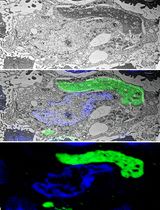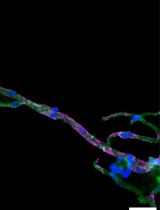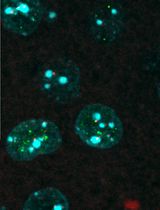- EN - English
- CN - 中文
Quantitative Nucleocytoplasmic Transport Assays in Cellular Models of Neurodegeneration
神经退行性细胞模型中核质转运的定量分析
(*contributed equally to this work) 发布: 2020年06月20日第10卷第12期 DOI: 10.21769/BioProtoc.3659 浏览次数: 5266
评审: Steven BoeynaemsAnonymous reviewer(s)
Abstract
Nucleocytoplasmic transport deficits are suggested to play a role in neurodegenerative disorders, including amyotrophic lateral sclerosis (ALS). Given the importance and complexity of this process, understanding when these aberrations occur and which pathways are involved is of great importance. Here, we make use of CRISPR-Cas9 technology to design cell lines stably expressing fluorophore proteins shuttling between the nucleus and cytoplasm by karyopherins of choice. To validate this protocol, we measured an ALS-associated nucleocytoplasmic transport pathway in the presence of the disease-associated peptide poly-PR. This technique allows measuring a particular active nucleocytoplasmic transport pathway in intact cells in a neurodegenerative disease-associated context. Moreover, these experiments can be performed without the need for expensive equipment and have the potential to be upscaled for high-throughput screening purposes.
Keywords: Neurodegenerative disease (神经退行性疾病)Background
Nucleocytoplasmic transport is crucial for cellular homeostasis and occurs across the nuclear membrane via large multi-protein complexes that form aqueous channels, called nucleopore complexes (NPCs) (Stoffler et al., 1999; Ryan and Wente, 2000). Although these channels allow small proteins to passively equilibrate across the nuclear membrane (passive transport), most proteins appear to be actively transported by karyopherins, namely importins or exportins (active transport). Cargo proteins that contain a nuclear localization signal (NLS) are targeted by importins. Various receptor-mediated import pathways have been identified, but the best characterized pathway involves importin-β1/importin-α (KPNB1/KPNAx) of which the cargos contain a classical NLS (cNLS), exemplified by the SV40 large T antigen NLS (Lange et al., 2007). Protein export from the nucleus into the cytoplasm is mediated by exportins. Several pathways of nuclear export have been identified. The most common type of nuclear export signal (NES) is a leucine-rich sequence motif recognized by exportin1 (XPO1), of which the NES from protein kinase inhibitor (PKI) is the most often used prototype (Ossareh-Nazari et al., 2001).
Altered subcellular distribution of proteins is a common characteristic among neurodegenerative disorders, such as Alzheimer’s disease (AD), Parkinson’s disease (PD), Huntington’s disease (HD) and amyotrophic lateral sclerosis (ALS) (Fahrenkrog and Harel, 2018). Increasing evidence indicates impaired nucleocytoplasmic transport as a possible mechanism explaining this aberrant protein localization in the degenerating neurons. For example, in the majority of ALS patients the RNA binding protein TDP-43 (Arai et al., 2006; Neumann et al., 2006) or, to a lesser extent, FUS (Kwiatkowski et al., 2009; Vance et al., 2009; Tyzack et al., 2019) becomes partially depleted from the nucleus and aggregates in the cytoplasm. Interestingly, the most common genetic cause associated with ALS, a G4C2-repeat expansion in the C9orf72 gene (Majounie et al., 2012), has been suggested to affect nucleocytoplasmic transport in various ways (Boeynaems et al., 2016; Yuva-Aydemir et al., 2018). One possible toxic pathway is the bidirectional translation of the repeat expansion by repeat-associated non-ATG (RAN) translation into dipeptide repeat proteins (DPRs), namely poly-GP, poly-GA, poly-GR, poly-PA and poly-PR (Ash et al., 2013; Zu et al., 2010; Mori et al., 2013a and 2013b). Here, we expressed the DPR poly-PR using a lentiviral vector transduced into our reporter cells, to subsequently measure nucleocytoplasmic transport.
Although there is growing evidence indicating that impaired nucleocytoplasmic transport is a component of neurodegenerative diseases, it is still under large debate whether nucleocytoplasmic transport deficits are a consequence of neurodegeneration or an instigator (Hutten and Dormann, 2019). As nucleocytoplasmic transport is a complex and stress-sensitive process, reliable assays with a minimal interference are essential to answer this question, as we did before (Vanneste et al., 2019). We developed several reporter cell lines stably expressing a shuttling-fluorophore allowing us to consistently measure nucleocytoplasmic import as a function of time and in intact cells without the need for transfection. Moreover, this method is cheap and can easily be up scaled for high throughput screening purposes. By fine-tuning the NLS and NES fused to the reporter, the subcellular localization of the reporter can be modified and different transport pathways of interest can be analyzed. While the experiments here are performed with Hela Kyoto cells, the protocol can easily be adapted for other cell types.
Materials and Reagents
- 6-well plate (Corning Life science, 3516)
- 96-well plate (TTP, catalog number: 92696 )
- T-25 culture flask (TTP, catalog number: 90026 )
- Cover Glass (VWR, catalog number: 631-0150 )
- Nunc CryoTube (Sigma, catalog number: V7884 )
- Hela Kyoto cells (Cellosaurus ID: CVCL_1922)
- HEK-293T cells (ATCC, catalog number: CRL-3216TM)
- pcDNATM 3.1 (+) plasmid (Thermo Fisher Scientific, catalog number: V790-20 )
- pGL4 plasmid (Addgene)
- Plasmid containing Cas9 was a kind gift from Jonathan L. Schmid-Burgk (Schmid-Burgk et al., 2016).
- Plasmid containing the gRNA was a kind gift from Jonathan L. Schmid-Burgk (Schmid-Burgk et al., 2016)
- GibcoTM Dulbecco’s Modified Eagle’s Medium (DMEM), high glucose (Thermo Fisher Scientific, catalog number: 11965092 )
- Fetal Bovine Serum (GE Healthcare, Hyclone, catalog number: SV30160.03 )
- GibcoTM Gentamicin (Thermo Fisher Scientific, catalog number: 15750045 )
- GibcoTM Puromycin Dihydrochloride (Thermo Fisher Scientific, catalog number: A1113802 )
- GibcoTM Trypsin-EDTA (0.05%), phenol red (Thermo Fisher Scientific, catalog number: 253000054 )
- LipofectamineTM 3000 Transfection Reagent (Thermo Fisher Scientific, catalog number: L3000015 )
- Dimethyl sulfoxide (DMSO) (Sigma, catalog number: D2650-100ml )
- Importazole (Selleckchem, catalog number: S8446 )
- Leptomocyin B (Invivogen, catalog number: tlrl-lep )
- NucBlue Live ReadyProbesTM Reagent Hoechst 33342 (Thermo Fisher Scientific, catalog number: R37605 )
- GibcoTM Dulbecco’s Phosphate-Buffered Saline (DPBS), no calcium, no magnesium (Thermo Fisher Scientific, catalog number: 14190250 )
- Formaldehyde 16 % methanol free, Ultra Pure (Polysciences Inc., catalog number: 18814-20 )
- Hexadimethrine bromide (polybrene) (MedChem Express, catalog number: 2878-55-4 )
- X-tremeGENE9 DNA transfection reagent (Sigma-Aldrich/Roche, catalog number: 06 365 809 001 )
- ON-TARGETplus KPNB1 siRNA human (Horizon Discovery, catalog number: L-01523-00-0005 )
- ON-TARGETplus KPNA2 siRNA human (Horizon Discovery, catalog number: L-004702-00-0005 )
- Gene Pulser Electroporation Butter (Bio-Rad, catalog number:165-2677)
- siRNA buffer (Horizon Discovery, catalog number: B-00200-UB-100 )
Equipment
- Incubator
- Forceps
- Mr. Frosty freezing container (Thermo Fisher Scientific, catalog number: 5100-0001 )
- Scanning confocal microscope, e.g., SP8 confocal microscope (Leica, model: SP8 MDi8 )
- CellInsight CX5 high content screening platform (Thermo Fisher Scientific, catalog number: CX51110 )
Software
- ImageJ (Wayne Rasband (retired from), https://imagej.nih.gov/ij/download.html)
- CellProfiler (Broad Institute, https://cellprofiler.org/)
- Snapgene (GSL Biotech LLC, https://www.snapgene.com/)
Procedure
文章信息
版权信息
© 2020 The Authors; exclusive licensee Bio-protocol LLC.
如何引用
Vanneste, J., Vercruysse, T., Van Damme, P., Van Den Bosch, L. and Daelemans, D. (2020). Quantitative Nucleocytoplasmic Transport Assays in Cellular Models of Neurodegeneration. Bio-protocol 10(12): e3659. DOI: 10.21769/BioProtoc.3659.
分类
神经科学 > 神经系统疾病 > 神经退行性病变
分子生物学 > 蛋白质 > 蛋白穿梭
细胞生物学 > 细胞成像 > 共聚焦显微镜
您对这篇实验方法有问题吗?
在此处发布您的问题,我们将邀请本文作者来回答。同时,我们会将您的问题发布到Bio-protocol Exchange,以便寻求社区成员的帮助。
Share
Bluesky
X
Copy link












